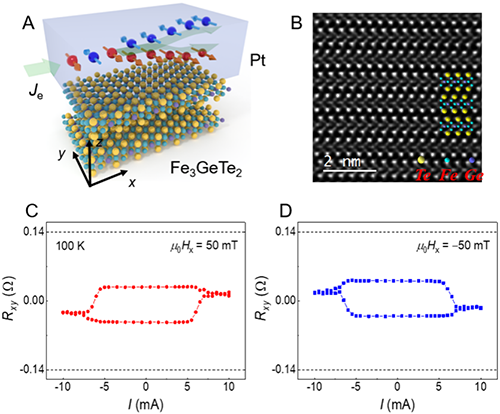Control the magnetization of a van der Waals ferromagnet by current
Date:21-08-2019 Print
Two-dimentional (2D) van der Waals (vdW) materials possess diverse electronic properties, providing new opportunities for building high-preformance electronic devices. The study on 2D vdW materials have mainly focused on the non-magnetic ones because the long-range magnetic order is theoretically firbidden in 2D systems according to the Mermin-Wagner theorem. However, the presence of magnetic anisotropy establishes an exception of such theorem and gives arise to the recent observations of intrinsic magnetism in 2D vdW materials.
Magnetic 2D vdW material provides a versatile platform for developing novel spintric devices, i.e., the basic elements of future non-volatile, high-speed, and long endurance storage technology. The large family of vdW materials and numerous combinations of vdW heterostructures remarkably extend the material choices and can be visioned as new building blocks for electronic and spintronic applications in the near future. In order to utilize 2D vdW ferromagnets for building spintronic nano-devices such as magnetic memories, key challenges remain in terms of effectively switching the magnetization from one state to the other electrically.
In a new study published on August 24 in Science Advances, a collaborated team of three groups from Chinese Academy of Sciences, including Prof. HAN Xiufeng’s group and Prof. ZHANG Guangyu’s group from Institute of Physics, and Prof. HAN Zheng’s group from Institute of Metal Research, has made a great progress in electrically controlling the magnetization of vdW magnets. The team developed a convenient method that is combining the ferromagnetism of vdW materials with the spin Hall effect of an adjacent heavy metal layer.
When an electrical current flows in the heavy metal, a spin current is generated and injected into the vdW magnet. The spin current then transfers angular momentum to the magnetic moment and induces a magnetization switching.
Based on this scheme, the researchers devised a bilayer structure of Fe3GeTe2/Pt, in which the magnetization of few-layered vdW magnet Fe3GeTe2 (FGT) can be effectively controlled by the spin current originated from the electrical current flowing in the Pt layer.
The magnetization of FGT can be switched from one state to the other by applying electric currents. Two distinct states can be well sustained at zero current, which is monitored by a positive or negative Hall voltage. These two distinct magnetic states and the corresponding output voltages can be encoded as “0” and “1” states in the magnetic memory application. This proof-of-concept spintronics device highlights the potential of magnetic vdW materials and their compatibilities with spintronic technologies.
Regarding the reported devices, there are still challenges for practical applications, such as room-temeprature 2D magnetism, low-density switching current, fabrication of wafer-scale 2D magnetic vdW materials, and the integration with present semcondictor technique. However, the study on 2D magnetic vdW materaisls just rise up. Their fast developments will further advance the performance of ultra-compact spintronics devices for practical applications.
This research work is led by Associate Prof. YU Guoqiang. The co-first authors include Xiao Wang, Jian Tang, and Xiuxin Xia. The co-corresponding authors include HAN Zheng, ZHANG Guangyu, andYU Guoqiang. The study was supported by the National Key Research and Development Program of China, the National Science Foundation, the NSFC-Science Foundation Ireland (SFI) Partnership Programme, the Strategic Priority Research Program (B) of CAS, the Key Research Program of Frontier Sciences of CAS, and the National Key R&D program of China.

Fig. A Schematic view of the bilayer structure. The green arrow in Pt layer represents the in-plane current flowing in the Pt layer, which generates a spin current flowing in z-direction. The accumulated spins at the bottom (top) Pt surface are indicated by the red (blue) arrows. The spin current exerts torques on the magnetization of FGT and can switch it in the presence of an in-plane magnetic field. B High-resolution scanning transmission electron microscopy image of the FGT crastal. C and D Current-driven perpendicular magnetization switching for in-plane magnetic fields of 50 mT and ?50 mT at 100 K. The switching polarity is anticlockwise and clockwise, respectively.
Contact:
Institute of Physics
YU Guoqiang
Email: guoqiangyu@iphy.ac.cn
Keywords:
Magnetization switching; 2D van der Waals ferromagnet; current-driven;
Abstract:
Researchers devise a bilayer structure of Fe3GeTe2/Pt, in which the magnetization of few-layered Fe3GeTe2 can be effectively switched by the spin-orbit torques (SOTs) originated from the current flowing in the Pt layer. Our demonstration of the SOT-driven magnetization switching in a 2D vdW magnet could pave the way for implementing low-dimensional materials in the next-generation spintronic applications.

